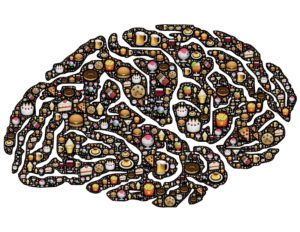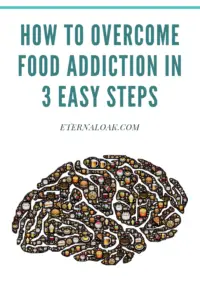Are you a food addict?

A loaded question if ever there was one. What does it mean to be a food addict? We all have to eat. But some of us get more deeply into it than others.
Here’s the list a questions to try on yourself.
- Do you eat past the point of feeling full at least once a week?
- Do you eat in secret? Do you find yourself sneaking out for fast food and trying not to let others know?
- Do you hide the trash from fast food excursions so others can’t see it?
- Do you eat alone often because others don’t care to join you at the places you like to go (e.g. McDonalds)?
- Do you go out of your way to get certain foods?
- Do you eat out alone even if you aren’t hungry, just because you’ve been thinking of a certain food you really want?
- Have you ever tried a diet with cheat days or meals and found yourself really looking forward to those cheats so much so that you think about it all week?
- Do you find you’re easily able to gorge and then over-gorge yourself on cheat days, almost as if you’re stocking up out of fear of deprivation later?
- Do you have a pattern of a big junk food day followed by 1-3 days of healthy eating then back to junk? Does it revolve like clockwork at least 3 or more times a week?
- Do you have a list of foods that give you extreme contentment?
- For me it’s mayo. Adding that to a sandwich and fries meal makes my happiness meter explode. If you’ve never experienced this you might not get the idea; however, if this rings a bell it’s a yes for you on this question. There are certain foods that hit us like a drug and you feel like sparkles and fireworks are going off inside of you.
If you find you eat junk food alone often, have certain foods that really hit the spot for you, and you have cycles of eating junk food followed by healthy meals (junk food binge and purge) you may be a food addict.
The first step is simple – know your enemy.
Step One. Know Your Enemy
First things first, you are not the enemy. You don’t have a gene that makes you prone to binging on certain foods. You don’t have some inherent flaw where you’ll have to fight this forever.
You have habits connected to unfulfilling foods. That’s it.
If you look back at the questions above about being a food addict you’ll see that most of them are asking about your regular habits:
- Do you eat alone?
- Do you overeat past fullness?
- Etc.
They point to the habits of food addiction. Food addiction isn’t a disease as much as it’s a series of habits that can be broken. And that’s the magic and the solution all in one. Find your habits, see their individual pieces, remove a piece, and you break the cycle.
The best thing about it is that once you understand the pieces of the habit, you can choose the easiest piece to disrupt. Willpower is optional. No need to make things difficult.
What are the three pieces of food addiction habits?
Habits are formed of three things – a trigger, an action, and a reward.
The Trigger
With food addiction habits the trigger usually falls into one of these categories
- Hunger
- Food advertising on TV, billboards, etc.
- Being near and seeing the actual restaurants
- Memories of favorite foods and restaurants
- Anxiety or stress from work
Of the three above hunger is one of the rarest triggers. This may be counterintuitive at first but few of us ever go long enough without eating to get truly hungry. The “hunger” we feel is really how we interpret other things going on inside:
- Work stress is converted to hunger because we remember eating reduced our stress in the past
- Advertising or seeing restaurants reminds us of eating there in the past and the pleasure it brought. We seek that pleasure again and thus “hunger” arises.
Actual hunger is fully satisfied by eating anything – an apple, a boiled plain potato without salt, raw broccoli. If you get hungry and feel drawn to an apple you know it’s true hunger. If given a choice between an apple and chips and you side with the chips, it’s likely stress relief that you seek.
The Action
Once triggered you move on to action. Internally, and you may be conscious of this or not, you’ll consider all your options. As discussed above, you’ll consider the apple versus the chips; you’ll consider the lunch you brought versus driving down the street for Taco Bell. You’ll weigh how you feel inside versus the various options and you’ll choose the one with the most “profit.” By “profit” we mean the greatest happiness per effort which brings us to the final part of habits – the reward.
The Reward
An apple will give you a ton of happiness if you’re really hungry. So will a bag of chips. But if you’re not really hungry but really just trying to relieve a little anxiety, that bag of chips is designed to elicit a much greater happiness response than that apple.
And thus the actions are chosen without much thinking on our part. That’s good. That kind of thinking kept us alive for millions of years, helping us to choose the most bang for our buck foods.
Such thinking and habits don’t work anymore. Food options are easy. Everything is available. Certain foods and habits make us fat, others give us six pack abs. So what’s the solution?
Step One. Know Yourself – 30 minutes
Get out a sheet of paper. Make 3 columns on a the paper like this.
Triggers Habits Rewards
Set a timer for 10 minutes. Start by writing down bad eating and/or drinking habits under the eating column. Don’t stop writing or pause to think until the time is up or the list is finished.
The list will be long. Go through it and circle the top 10. You’ll focus on those for the triggers and rewards.
Now for each habit you circled fill out the triggers. Do just the triggers first. It’s important. Many of them will be the same but this is your time to fully brainstorm all the possible triggers. If you try to do triggers and rewards you’ll just confuse yourself and you won’t go as deep into possible triggers as you can.
Things to consider when filling out triggers – what were you feeling right before the habit? What were you thinking about? Did anything happen? More often than not consistent habits have consistent triggers – either externally or internal.
Lastly fill out the rewards. Again, only do the rewards column till it’s done. Dive deep and really look inside to see what you get out of these habits.
Congratulations. You’ve just deconstructed most of your worst eating habits. Now that they’re in the light they lost a lot of their power. These habits work best in the dark when you aren’t conscious you’re doing them.
You’ve just exposed them and they’ve got nowhere to hide anymore. Now Let’s finish them off.
Next we’re going to take that list and find strategic ways to tackle each habit.
Step Two. Build Your Fortress and Stock the Arsenal
You’ve built a list of all your bad habits. You prioritized them and now have a smaller list of the worst of the worst. Then you dove deep to figure out what triggers each habit and the reward you get out of it.
Now you’re going to look at each habit and change one thing for each. Take another sheet of paper and create three columns:
New Trigger New Habit New Reward
Put the two pieces of paper side by side.
Now, for each bad habit look at the trigger, habit, and reward and ask yourself:
- Can I change any of these triggers? Can I remove things from my workplace or home? Can I add new triggers like bowls of fruit in plan view
- If I can’t change the trigger, can I change the habit and get the same reward?
- Can I change the habit and get a similar or even better reward?
Step Three. Winning the Food War
By now you are probably pretty excited about step three. It’s time to put your new habits into action. Test changes for 1 – 3 habits over the next week.
The easiest way to stick to them is print off a weekly calendar, add the habits to it for each day, then put X’s next to each as you complete them each day.
At the end of the week do a quick assessment. Were they easy to stick to? Did it affect other habits?
If you couldn’t stick to all of them every day then choose the one habit that’s most important and redo it for the next week and only stick to that one. Limit the run to just 3 – 5 days.
How to Break a Food Addiction Habit in Action
You don’t need to break the whole habit. You only need to break one of it’s parts and replace it with something better. Let’s take a look again at the three parts of a food addiction habit using an example.
It’s late afternoon at work. You’ve already eaten lunch two hours ago. Salad with grilled chicken and super light on the dressing. You’re feeling good about yourself on your choices so far but we’re not out of the woods yet. You get in a little argument with your boss. A little issue that’s been a recurrent theme. You go back to work but within 30 minutes, after things have calmed down you find yourself thinking of food. Next thing you know you’ve eaten two mini bags of chips from the snack room.
What happened? Let’s break this down into its component parts.
The trigger was stress. The little argument wasn’t such a big deal since it’s happened before but it used up the last of your willpower.
You wanted stress relief since you still had a few hours of work left. You considered your options and the biggest bang for the buck was the chips, not the apple.
You got the reward. After eating the chips you felt great. That’s what mattered to your subconscious. You felt guilty afterwards but that small little pain was nothing compared to the pleasure the chips brought.
In short, the trigger, stress, was followed by the action, chips, which was followed by the reward, restored willpower.
So how do we break this cycle?
You don’t have control over the stress trigger. That comes from someone else.
You want the restored willpower and reduced stress so no need to change the reward.
You just need another action that will give you energy, turn off your brain for a bit, and give you a reset.
Try fruit. It’s just as fast as chips. Gives you a little food energy along with fiber to restore your willpower. Plus it’ll occupy your brain and get your mind off the worries.
There are lots of other things you can do – meditate, journal, go for a short walk around the block, etc. Make a list, choose the one that feels easiest, and break the cycle.
Enjoy this article? Please share it with your friends via Pinterest, Facebook, or Twitter using the buttons at the top and bottom of this article.
